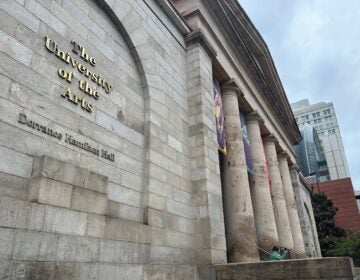Meet the activist who fought for American Indians’ voting rights — her face may be on your next quarter made in Philly
Once a teacher at the Carlisle Indian Industrial boarding school, she left to expose the abuses there and fought for American Indian voting rights in the early 1900s.
Listen 1:04
American Indian Zitkala-Ša also known as Gertrude Simmons Bonnin was once an Indian boarding school teacher in Carlisle, Pennsylvania. She became an American Indian civil rights activist in Washington D.C. And is credited with helping indigenous people get the right to vote and American citizenship. She was also an artist and wrote the first American Indian opera but died before its New York City premiere. Born on the Yankton Sioux Tribe reservation in South Dakota she is buried in Arlington National Cemetery.
From Philly and the Pa. suburbs to South Jersey and Delaware, what would you like WHYY News to cover? Let us know!
Gertrude Simmons Bonnin, also known as Zitkála-Šá, may not be nearly as recognizable as former U.S. President George Washington, but her face will share a quarter with him in your pocket soon enough.
That’s because she was chosen to be sculpted by artists and memorialized in metal by the U.S. Mint in Philadelphia and at the Denver operation as well.
The U.S. Mint uses a blend of copper and nickel on the production line which is then mass-produced for use as official currency.
Her coin will start shipping to the U.S. Federal Reserve banks nationwide on October 21. Then financial institutions like banks and credit unions can purchase those quarters from the Federal Reserve.
Zitkála-Šá is in the latest batch of quarters as part of a national program that honors great American women leaders.
On the back of the coin, she wears a traditional South Dakota Sioux tribe dress. She’s holding a book to signify that she was a published author. The diamond design behind her is inspired by Sioux tribe artisans.
The sun represents the name of her opera, which was based on a traditional dance from her home community of the South Dakota Sioux tribe reservation of Yankton known as “The Sun Dance Opera” and was shown to audiences nationwide.
The cardinal, which would be red if the coin had any color, is an homage to her chosen name of Zitkála-Šá, which is roughly translated in English as Red Bird from the Lakota language.
In 1897, she was a boarding school teacher in Carlisle and the graduate of an Indian boarding school herself that the federal government funded. These boarding schools forcibly removed Indigenous children from their homes, families and culture as an attempt to assimilate them into organized religion and American culture at the time.
But she left her post at The Carlisle Indian Industrial School after an argument with the school’s controversial founder, opposing his practices and treatment of American Indian children. Capt. Richard Henry Pratt once said that his philosophy was to “kill the Indian in [children] and save the man” at these boarding schools.
After leaving, Zitkála-Šá exposed those abuses in her published works in magazines such as the Atlantic Monthly in the early 1900s.
She became an American Indian civil rights activist in Washington D.C. and is credited with helping American Indian people get the right to vote and American citizenship. That’s because in 1924 when the Indian Citizenship Act granted such rights it did not include voting. So she co-founded the National Council of American Indians to change that and did.
She was also an artist and musician. She is credited with writing the first American Indian opera but died before its New York City premiere in 1938.
Retired University of Nevada Las Vegas English professor P. Jane Hafen told PBS in a special that aired in August 2020, that during Zitkála-Šá’s time, “native people weren’t even viewed as human beings.”
Hafen, who hails from the Taos Pueblo sovereign nation bordering New Mexico, edited a book of Zitkála-Šá’s works published in 2005.
Zitkála-Šá was born in South Dakota on the Yankton Sioux Tribe reservation and is buried in Arlington National Cemetery in Virginia.
“As I have studied the life and writings of Gertrude Bonnin, I found a spirited and determined woman,” Hafen wrote in her book. “She was driven by a passion for justice and her commitment to her Yankton background. The choices she made reflect the paradoxes we American Indians continue to face. She clung to her traditional beliefs while practicing Catholicism and other versions of Christianity; she had a Mormon funeral in Arlington, Virginia. She performed in public arenas and pandered to sentimental colonial images while demanding legal rights and national sovereignties for Indians.”
Hafen was not available for an interview for this story. Neither was Yankton Sioux Tribe chairman Robert Flying Hawk.
The community is a sovereign nation bordering South Dakota and held its council meeting last week, which officials say “can last all day.”
To watch a PBS Digital documentary about Zitkála-Šá’s life, click here.

Get daily updates from WHYY News!
WHYY is your source for fact-based, in-depth journalism and information. As a nonprofit organization, we rely on financial support from readers like you. Please give today.






